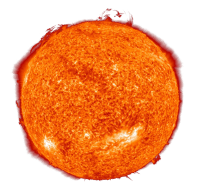Hitting the Sun
I’ve heard a few people talk about ways to creatively dispose of spent nuclear waste. One of the crazier ideas heard is to launch it into orbit on a rocket, then point this rocket towards the Sun and fire a big engine. Soon the pull of the Sun’s gravity will take over, and the waste will accelerate towards the Sun, and be absorbed harmlessly. Right?
 Image: I G
Image: I G
Leaving aside the complete madness of launching a huge quantity of dangerous material into orbit (launches have a far from perfect safety record; nowhere near the five nines that would be needed to minimize the chance of atomizing tons of highly toxic material into the atmosphere), and the fact that there a hundreds of thousands of tons of waste to dispose of (pretty much requiring non-stop launches); it simple won’t work!
If you point a rocket directly at the Sun from Earth orbit, no matter how powerful your rocket is, you are going to miss!
If you point a rocket directly at the Sun from Earth orbit, no matter how powerful your rocket is, you are going to miss!

Why?
The Sun is approximately 150 million km (93 million miles) away from the Earth.
The Earth orbits around the Sun with an average speed of 29.78 km/s (107,208 km/h; 66,616 mph). That’s pretty fast. If we launch an object from the Earth and it goes into orbit around the Earth, this object, whilst spinning locally around the Earth, is also orbiting around the Sun.
The reason the Earth (or any of the other planets) do not simply get pulled into the Sun is that they are constantly falling around the Sun (that’s what an orbit is). The Sun comprises 99.8% of the mass of our entire Solar System and exerts a big force. Each planet has sufficient tangential velocity that, with gravitational pull from the Sun, it constantly falls around the Sun. Kepler’s laws dictate how long it takes the planet to orbit (based on its radius from the Sun).

A rocket in orbit (with its nuclear payload) inherits this tangential velocity from the Earth. If you point this rocket at the Sun, it’s going to whizz towards the Sun, but miss, taking an elliptical orbit (with the Sun as one focus), and come back to pretty much where it started.
The only way to get something to fall into the Sun is to remove all of it’s tangential velocity so it will simply get pulled ‘in’ as you want, and not pulled ‘around’, which is what will happen if you have any tangential component.
Energy
Cutting to the chase, it requires approximately 55 times more energy to get to the Sun (from the Earth) than it takes to get to Mars! To get to Mars, you need to give energy to the payload to speed it up. To get to the Sun, the energy must be used to slow down the projectile; cancelling out the radial velocity the projectile inherited from the Earth.
Advertisement:
Parker Solar Probe
In 2018, NASA launched a mission towards the Sun. The goal of the mission is to get a probe closer to the Sun than any other previous device); closer than 10 solar radii. It will slowly get closer to the Sun by repeatedly flying by Venus and using a (reverse) gravity assist maneuver to scrub off speed (imperceptibly increasing the speed of Venus as they trade momentum). By 2025 it will make its closest approach, taking measurements and observations of the corona of our nearest star. Below is a video from NASA about the project.
Source: NASA
Gravity assist is needed because we currently don’t have the technology to build a rocket powerful enough to slow down a sensible sized payload enough to get it close to the Sun.
Interestingly, it would be better for the Parker probe to get its gravity assist decelerations from Jupiter (a much more massive entity), instead of Venus, but Jupiter is a long way away. This would take more time but, more importantly, place too much demand on the spacecraft (which needs power). Jupiter is too far out into space to get meaningful power from solar panels, so the spacecraft would need to have been installed with a nuclear core to generate the necessary power the spacecraft would need. This is dangerous and, ironically, brings us right back to the start of the this article which highlights the danger of launching radioactive material into the sky on the top of a controlled explosion!
 Image: NASA
Image: NASAThe Parker Solar probe will drop approximately 53,000 miles per hour of tangential speed from its half dozen encounters with Venus (if it had been able to use Jupiter, it could have handled this with just two). Another claim to fame is that it will become the fastest man-made object so far. At the end of its mission it will have accelerated to 430,000 miles per hour (0.064% the speed of light).
More Space and rockets
If you liked this article, you might be interested in the Beginner's Guide to Astronautics I wrote last month which gives more background and provides more math related to the energy needed to escape a gravity well.
